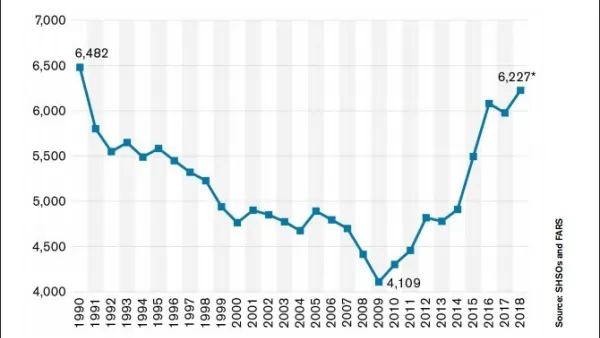Pedestrian deaths are on the rise in the United States, but cities have been slow to implement effective policies and road design measures to change the trend.

While the number of pedestrian deaths has been dropping in other countries, the United States is projected to reach a high not seen in 30 years, reports a team from the Howard Center for Investigative Journalism at Arizona State University.
Drivers are safer than ever in vehicles outfitted with a number of features to better protect them. However, experts do not agree on the causes behind the increase in pedestrian fatalities. They point to distracted driving and an increase in walking, but these factors do not adequately explain the trends seen here in the United States and other countries.
And a closer look at the data indicates that certain places have been disproportionately affected. "The threat posed by vehicles is exacerbated by road designs in many of the country’s most dangerous locations for pedestrians — mostly low-income, predominantly minority neighborhoods in heavily populated Sun Belt cities, such as Los Angeles, Phoenix, Houston and Orlando, Fla."
Arterial roads in these areas are wide with high traffic volumes and speeds. "Many of these roads, which are designed for vehicle speeds of over 40 mph, are hostile to pedestrians. They have sidewalks that abut the travel lanes with minimal separation and lack median islands or sufficient lighting."
Some cities have adopted Vision Zero initiatives to address road safety, but others—such as Phoenix, which has one of the highest pedestrian fatality rates in the country—have fully rejected such strategies. In addition, the European Union has adopted vehicle safety standards to better protect pedestrians, but the National Highway Traffic Safety Administration says such regulations did not pass a required cost-benefit analysis.
FULL STORY: Pedestrians die every 90 minutes in the U.S., and low-income areas are hurt most

Analysis: Cybertruck Fatality Rate Far Exceeds That of Ford Pinto
The Tesla Cybertruck was recalled seven times last year.

National Parks Layoffs Will Cause Communities to Lose Billions
Thousands of essential park workers were laid off this week, just before the busy spring break season.

Retro-silient?: America’s First “Eco-burb,” The Woodlands Turns 50
A master-planned community north of Houston offers lessons on green infrastructure and resilient design, but falls short of its founder’s lofty affordability and walkability goals.

Test News Post 1
This is a summary

Analysis: Cybertruck Fatality Rate Far Exceeds That of Ford Pinto
The Tesla Cybertruck was recalled seven times last year.

Test News Headline 46
Test for the image on the front page.
Urban Design for Planners 1: Software Tools
This six-course series explores essential urban design concepts using open source software and equips planners with the tools they need to participate fully in the urban design process.
Planning for Universal Design
Learn the tools for implementing Universal Design in planning regulations.
EMC Planning Group, Inc.
Planetizen
Planetizen
Mpact (formerly Rail~Volution)
Great Falls Development Authority, Inc.
HUDs Office of Policy Development and Research
NYU Wagner Graduate School of Public Service



























